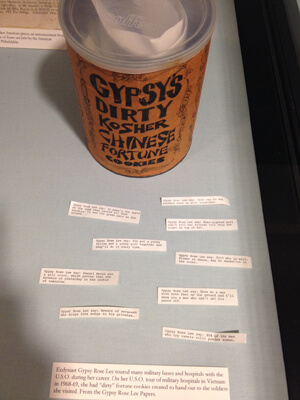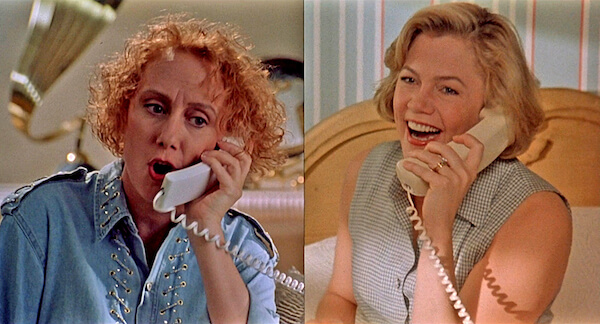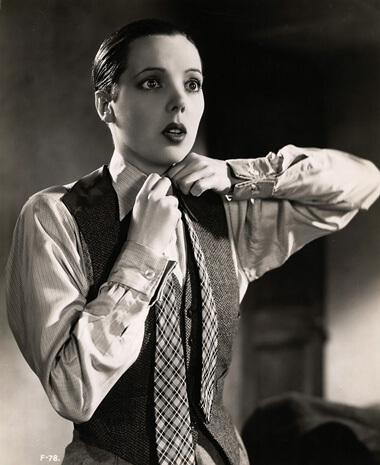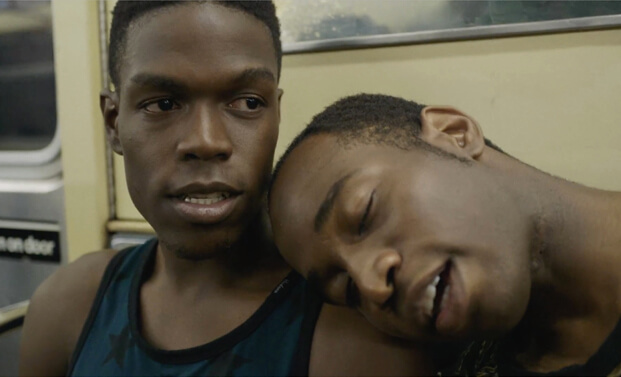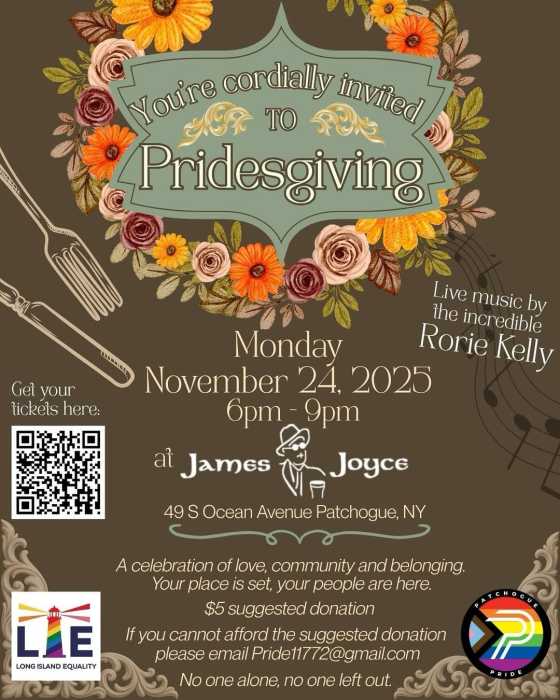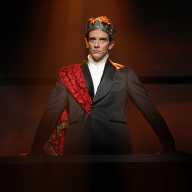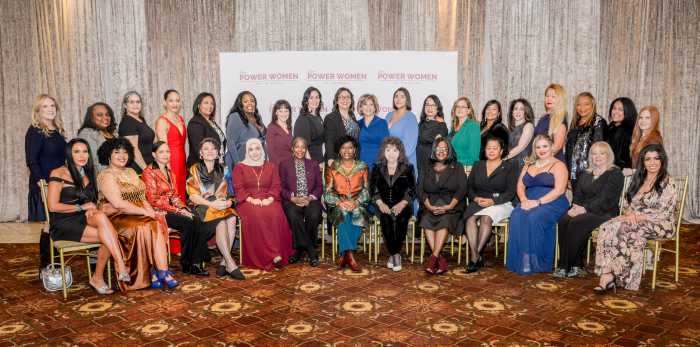The master’s sketch of a Broadway audience, as seen in “The Line King: Al Hirschfeld” at the Library for the Performing Arts. | LIBRARY FOR THE PERFORMING ARTS AT LINCOLN CENTER
BY DAVID NOH | Disarming young talent has recently been ruling at 54 Below. On November 25, I caught adorable two-time Tony nominee Robin De Jesús’ “Crush to Crushed,” which unapologetically charted the search for gay love and what happens once you find it.
A veritable firecracker of energy onstage, De Jesús offered enviable vocal chops in what was essentially a pop cover act, delightfully indulging himself in singing songs originated by women from Beyoncé to Miley to Britney. When the songs’ narrative turned sour, relationship-wise, I enjoyed his gleefully abrasive rendition of Ben Folds Five’s “Song for the Dumped.” Calming down a bit, he offered a lovely change-of-pace “I Wish You Love.” His frenetic stage patter was often hilarious, detailing his own personal vocabulary, with the usage of “That’s so Equity” to offer the highest praise, and “You stay over there; Namaste over here!”
Sierra Boggess’ gig on December 4 was quite the model for any youngster wanting to learn how to put together a great cabaret act, with enough melody, humor, and sparklingly delivered personal info to give you a real idea of who she is. As if sending a charmingly covert f.u. to producers who hire reality TV stars to carry live televised Broadway adaptations, she took the stage with “I Have Confidence” from “The Sound of Music,” and immediately proved how much more suited for the role she would have been than that poor, stiff, off-pitch girl with the typewriter name.
Robin and Sierra delight, enthralling exhibits, an almost saintly riot grrrl
Her immaculate soprano showed impressive range, glowing especially on two arias from “La Bohème,” and a ravishing “Smoke Gets in Your Eyes,” which once more illustrated how amazingly versatile theater actresses have to be these days, and, miraculously, sometimes are. And, although it’s been done, her jaw-droppingly fast mash-up of pop stars warbling show tunes (think Britney doing “Phantom”) and opera singers attempting the same (think Susan Graham as Evita) was gloriously irresistible. The show even became a family affair when she brought her lovable, obviously ex-hippie dad onstage to accompany her on a lovely country song while her sister played the cello. Why do I call him a hippie? Her sister’s name is Summer.
Producer Harold Prince, one of Boggess’ true mentors, sat next to me, raving to his table, “I told you she was great!” Boggess is one of the stars of his autobiographical revue, “The Prince of Broadway,” slated to hit Broadway in 2016, and she delivered ample, winning proof for his enthusiasm.
The Library for the Performing Arts at Lincoln Center (40 Lincoln Center Plaza; nypl.org/locations/lpa) is currently hosting a number of wonderful exhibits you could easily spend an afternoon exploring. “The Line King: Al Hirschfeld” has to be the definitive survey of this great caricaturist’s career, which made him as essential a part of New York life as the Empire State. I was especially intrigued to see the work of his youthful influences and cohorts, like the great Miguel Covarrubias, as well as Hirschfeld’s earlier work for theater and the movies, which I prefer to his later, starker style for the richness of its comic detail. One drawing, of a typical Broadway audience, half of them sound asleep, while the others make nuisances of themselves with unwieldy overcoats, noise-making, and distracting penlights, is absolutely timeless, totally illustrative of so much of my life today.
For all you devoted “Nina” obsessives, there’s a full section dealing, in beguilingly exhaustive detail, with Hirschfeld’s beloved habit of inserting his daughter’s name into his drawings. Who knew that Whoopi Goldberg was among the most obsessed?
A lesser-known, but once just as essential a Broadway personality was photographer Florence Vandamm (1883-1966), whose classic images of personalities and productions had a wonderful clarity and dramatic power to them. Born in London and trained at the Royal Academy, she first established herself in the West End and came to America with her American engineer husband in 1923. She opened a studio on West 57th street and, for 25 years, was Broadway’s photographer of record.
A photograph of dancer and choreographer Carmen de Lavallade by Florence Vandamm. | LIBRARY FOR THE PERFORMING ARTS AT LINCOLN CENTER
A stroll through her library exhibit yields a priceless trove of theatrical memories from the Great White Way’s Golden Age. Vandamm had a particularly close relationship with Alfred Lunt and Lynn Fontanne and the erstwhile First Lady of the Theater, Katharine Cornell. Her portraits of Fontanne and Cornell glowingly capture these women’s ineffable, imperious beauty from a time when real stars were uniquely distinctive, resembling no one else.
Vandamm, much like Edward Steichen, recorded the simple truth, and it’s instructive to see that she was no George Hurrell when it came to an easy glamorization of her subjects, as witness her shots of actress Esther Ralston. As photographed by her on an entire contact sheet, Ralston, ordinarily one of the screen’s great beauties, strangely comes across as a total nothing, quite plain.
Don’t leave the library before going up to the third floor to catch yet another little exhibit in a space many overlook but I’ve always found rewarding since discovering a tribute to the late, great costume designer Martin Pakledinaz there. Displayed in cases are various bibelots culled from the Library’s vast archives — Sarah Bernhardt’s Art Nouveau belt, pins belonging to Ruth Chatterton and Gertrude Lawrence, Cole Porter’s cigarette cases, and, most amusingly, Gypsy Rose Lee’s Dirty Kosher Chinese Fortune Cookies. It’s a homemade can filled with dirty jokes on slips of paper, which Lee handed out to soldiers during her USO tour in Vietnam. Example: “Gypsy Rose Lee say: Beware of sergeant who sings love songs to his privates.”
Another Broadway legend was celebrated at the Julie Harris memorial at the Bernard Jacobs Theatre on December 3. Harris was the first actress I ever became truly aware of, when — in one of my earliest memories — I watched “The Member of the Wedding,” based on the Carson McCullers novel, on TV. Harris’ bizarre tomboy sprite of a girl was spellbinding, talking about her loneliness and the crusts on her elbows, but even more so was the character of little sissy boy John Henry (brilliantly played by Brandon deWilde), who could have been me. (When deWilde died, I was completely distraught, running downstairs to the hotel lobby where my mother worked screaming, “Mommy!”) In the years since, Harris’ performance has become the ultimate touchstone for me, as well as so many others. The tribute included a Charlie Rose episode in which Dames Judi Dench and Maggie Smith both extolled that performance as one they could never top. Laurette Taylor’s “Glass Menagerie” was sadly never filmed, but Harris’ sheer incandescence as McCullers’ Frankie Addams has thankfully been recorded for all to marvel over.
Taylor’s fabled quality of realness — not acting — was something Harris shared, and what speaker after speaker at her tribute lauded. Joan Van Ark appeared, almost a ringer for Harris herself, dressed in a Noel Taylor gown Harris never wore but gave to her, with a bagful of cards and additional gifts from the actress she shared with the audience. Christopher Plummer was stirringly eloquent, as he always is when recalling his great contemporaries (definitely read his memoir, “In Spite of Myself”). Wonderful Zoë Akins was deliciously wry, thunderously stating, “I never liked Julie Harris!” The reason for this was her husband, producer Robert Fryer, always telling her to “Be like Julie” — i.e., read her lines simply, no acting — with an air of expectation. Rosemary Harris recalled a man on a bus squeezing her knee and telling how much he loved her in “The Belle of Amherst,” and getting off before she could correct him that that was the other Harris. She remembered a time when there were four theatrical Harrises — herself, Julie, Barbara, and columnist Radie, the redoubtable one-legged journalist of whom it was said all Broadway was at her foot. I do wish Rosemary hadn’t listened to her husband, who she said told her to cut two-thirds of her speech. With her rich professional history, beautiful voice, and rare graciousness, she is one of the few people alive I always long to hear more from.
Gypsy Rose Lee’s Dirty Kosher Chinese Fortune Cookies is a hidden treat at the Library for the Performing Arts.| LIBRARY FOR THE PERFORMING ARTS AT LINCOLN CENTER
An exhibit any movie lover must see is “Dante Ferretti: Designing for the Big Screen” at MoMA through February 9 (11 W. 53rd St.; moma.org). A very good case could be made for Ferretti as the greatest art director in movie history for his magnificent work, creating the looks for works by Fellini, Scorsese, Pasolini, Zeffirelli, Coppola, Terry Gilliam, Tim Burton, and so many others. The show is innovatively done, with numerous hanging screens — like laundered sheets — to wander through, on which are projected essential film clips, lending a mesmerizingly surreal air.
Hanging on the walls, Ferretti’s sketches for visual feasts like “Hugo,” “The Age of Innocence,” “Titus,” “The Adventures of Baron Munchausen,” “Sweeney Todd,” and the notorious “Salò” easily rank as pure works of art in themselves. Accompanying the show is an amazing 22-film retrospective that shows the breadth of this man’s output. Clad in a black Chinese jacket, at the press preview, he was endearingly modest, citing his partnership with his wife, set decorator Francesca Lo Schiavo, as essential to his career.
Sini Anderson’s “The Punk Singer” is a marvelous documentary about Kathleen Hanna, feminist icon of the 1990s, singer with Bikini Kills and Le Tigre, and founder of the riot grrrl movement. Married to Beastie Boy Adam Horovitz, she stopped performing in 2005. A long undiagnosed case of Lyme disease was one of the reasons for that, along with the forthrightly down-to-earth yet complex artist’s uneasy relationship with fame, beginning from the days when her female fans would be in physical danger at her concerts in the raging boy-dominated world of punk rock. In the film, she comes off as a beautiful in every way, endlessly political being, and, at the in-person Q & A that followed the opening night screening, was all that and more, relating to her adoring audience with a rare authenticity that was heart-warming.
I cannot let this column end without a tip of the hat to New Ohio Theatre’s “The Mutilated.” Apart from a lovable “The Gnädiges Fräulein” I caught in New Orleans last year, this was simply the best Tennessee Williams production I have seen in years, after so many truly disappointing, more expensive movie star-ridden revivals on Broadway and Off. The design and wondrously alert direction by Cosmin Chivu were perfection, as was the inclusion of a live Dixieland band, all of it providing a fabulously seedy frame for two sterling portraits of down-and-out ladies managing to survive with the questionable aid of frequent slugs and occasional thugs.
Mink Stole, never better, played the more proper Blanche DuBois-delusionary of the two, with apt, curdled daintiness, while Penny Arcade, resembling Elizabeth Ashley’s somewhat dumpier sister, crowned her picaresque career with a gesturally terrific, all-out performance that would have had old Tenn himself cackling with glee.

